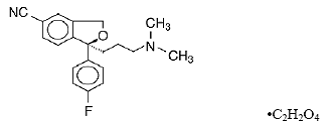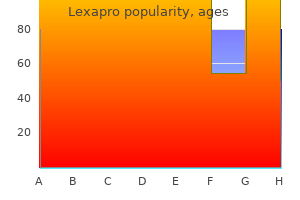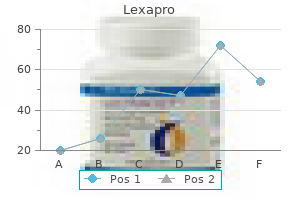Lexapro
"Cheap 10mg lexapro free shipping, depression definition quotes".
By: W. Renwik, M.B.A., M.D.
Deputy Director, Touro College of Osteopathic Medicine

Virulence ranking of some Mycobacterium tuberculosis and Mycobacterium bovis strains according to their ability to multiply in the lungs depression suicidal order lexapro us, induce lung pathology depression test had purchase lexapro with a visa, and cause mortality in mice anxiety keeping me from working buy lexapro 5mg fast delivery. An ideR mutant of Mycobacterium smegmatis has a derepressed siderophore production and an altered oxidative-stress response depression lab test order lexapro 5 mg on line. Protective role of the mycobacterial IdeR against reactive oxygen species and isoniazid toxicity. Iron-cofactored superoxide dismutase inhibits host responses to Mycobacterium tuberculosis. Reprogramming of the macrophage transcriptome in response to interferon- and Mycobacterium tuberculosis: signaling roles of nitric oxide synthase-2 and phagocyte oxidase. Unravelling the biology of macrophage infection by gene expression profiling of intracellular Salmonella enterica. Transient requirement of the PrrA-PrrB two-component system for early intracellular multiplication of Mycobacterium tuberculosis. Surfactant protein D binds to Mycobacterium tuberculosis bacilli and lipoarabinomannan via carbohydrate-lectin interactions resulting in reduced phagocytosis of the bacteria by macrophages. A coat protein on phagosomes involved in the intracellular survival of mycobacteria. A Salmonella locus that controls resistance to microbicidal proteins from phagocytic cells. Wholegenome comparison of Mycobacterium tuberculosis clinical and laboratory strains. The identification of rofA, a positive acting regulatory component of prtF expression: use of an m -based shuttle mutagenesis strategy in Streptococcus pyogenes. Evidence for inhibition of fusion of lysosomal and prelysosomal compartments with phagosomes in macrophages infected with pathogenic Mycobacterium avium. Investigation of mycobacterial recA function: protein introns in the RecA of pathogenic mycobacteria do not affect competency for homologous recombination. Regulation of the Bacillus subtilis fur and perR genes by PerR: not all members of the PerR regulon are peroxide inducible. Pulmonary surfactant protein A mediates enhanced phagocytosis of Mycobacterium tuberculosis by a direct interaction with human macrophages. A novel mycolic acid cyclopropane synthetase is required for cording, persistence, and virulence of Mycobacterium tuberculosis. The Mycobacterium tuberculosis IdeR is a dual functional regulator that controls transcription of genes involved in iron acquisition, iron storage and survival in macrophages. Characterization of murine lung dendritic cells infected with Mycobacterium tuberculosis. The origins of Mycobacterium tuberculosis and the notion of its contagiousness, p. An inhibitor of exported Mycobacterium tuberculosis glutamine synthetase selectively blocks the growth of pathogenic mycobacteria in axenic culture and in human monocytes: extracellular proteins as potential novel drug targets. Effects of overexpression of the alkyl hydroperoxide reductase AhpC on the virulence and isoniazid resistance of Mycobacterium tuberculosis. Mycobacterium tuberculosis induces differential cytokine production from dendritic cells and macrophages with divergent effects on naive T cell polarization. Use of an arrayed promoter-probe library for the identification of macrophageregulated genes in Mycobacterium tuberculosis. Aromatic-dependent Salmonella typhimurium are non-virulent and effective as live vaccines. Attenuation of and protection induced by a leucine auxotroph of Mycobacterium tuberculosis. Legionella pneumophilia inhibits acidification of its phagosome in human monocytes. Structure and antigenicity of the phosphorylated lipopolysaccharide antigens from the leprosy and tubercle bacilli. Molecular genetic characterization of whiB3, a mycobacterial homologue of a Streptomyces sporulation factor.
Most directed mutations in mycobacteria are performed with bifunctional or shuttle plasmid vectors that can be maintained in E anxiety therapy lexapro 20mg otc. Circular plasmid integration jammerdepression definition purchase cheap lexapro online, using a vector that cannot replicate in the recipient or has a temperature-sensitive (ts) replicon (216) depression symptoms wife purchase lexapro 5mg overnight delivery, is the most widely used method for directed gene disruption by allelic replacement in mycobacteria (187) mood disorder jesse order lexapro american express. It usually entails a two-step process in which the plasmid containing the desired gene disrupted with an antibiotic resistance cassette integrates into the genome by a single crossover event (Campbell-type integration) at the region of homology, selecting for the antibiotic resistance cassette. This event forms a direct repeat at one of two positions relative to the antibiotic cassette. In a second crossover event, the plasmid backbone is excised by means of recombination at the other direct repeat than the one initially used, when the antibiotic selection is maintained, resulting in the desired gene disruption. This technique can be relatively efficient when coupled with a counterselection to facilitate plasmid elimination in the second step. Two methods have been used for counterselection; the first is resistance to streptomycin (Strr), using wild-type rpsL in the plasmid vector and a mutated rpsL (Strr) allele in the chromosome of the recipient (250). Since the sensitive rpsL allele is dominant, resistance to streptomycin is observed only when it is lost along with the plasmid backbone, leaving the unique rpsl (Strr) chromosomal gene. The second counterselection is sucrose resistance when sacB encoding levansucrase is in the plasmid backbone. This enzyme converts sucrose to levans that are toxic to cells such as mycobacteria that lack a functional levanase that coverts levans to fructose and glucose (215). In both cases, the presence of the vector in the bacterial chromosome prevents bacterial growth on selective media, i. Of the two methods, the sacB selection is easier because one does not have make a specific Strr recipient in which rpsL, but not rrnA, is mutated. Another advantage to the sacB sucrose counterselection is that it can be used to introduce silent or unmarked mutations into the chromosome of the recipient, dispensing with the need for any antibiotic resistance marker. The drawbacks of the two-step procedure are, again, the necessity for a unique restriction site in the gene of interest coupled with the time required for the process, i. In addition, mutations that inactivate the plasmidborne rpsl or sacB during the selection and counterselection procedure will be erroneously scored as desired events in which the plasmid has been excised from the chromosome. A way of avoiding these false-positive results is to introduce another easily screenable marker in the plasmid backbone that should also be eliminated with the vector. An Strr cassette (244) and reporter fusions that give a visible plate phenotype have been used for this purpose, including fusions with xylE (327) and lacZ (209). These events can be unstable, however, since recombination at the direct repeats in the chromosome formed during the plasmid integration, which is the basis of the two-step plasmid procedure, can lead to excision of the plasmid, restoring the intact wild-type gene, in the absence of the selecting antibiotic. A new method of directed gene inactivation, termed specialized transduction, using a ts bacteriophage delivery system has been described recently that bypasses these problems and is the current method of choice for directed mutation (108). Bardarov, the inventor of the mycobacterial specialized-transduction system, is quite useful because it gives a detailed description of the method. This article also shows how the resolvase system can be used to make silent mutations in mycobacteria, allowing the creation of multiply mutated bacterial strains (14). This allows the formation of viable transducing bacteriophage particles by an in vitro packaging reaction that can be transduced into E. Transductants are then selected on antibiotic-containing media for events in which the M. This technique is very efficient because essentially all of the recipient cells can be transduced and the selection is robust. These events require a selectable phenotype, generally an antibiotic resistance marker carried within the transposable element. Two groups have developed efficient transposition systems that produce integration events in the genomes of mycobacterial species, including M. These systems use transposable elements carried by vectors that cannot replicate at temperatures above 39°C: in one case, a ts plasmid that carries Tn 1096 (216), and in the other, a ts bacteriophage, similar to the one described in the previous section, that carries Tn 5367 or Tn 5370 (15). A transposition system has been developed more recently from the mariner transposable element Himar-1 that overcomes some of these drawbacks.

Only closed vehicles shall be used in transporting foods from central kitchens to other schools depression era glass cheap lexapro 10mg otc. Broader than universal precautions (many state laws refer to this term) depression definition fr lexapro 5mg low cost, standard precautions are recommended practice for protection against transmission of bloodborne pathogens and other infectious diseases in the workplace bipolar depression symptoms in women order lexapro 20 mg without a prescription. They combine the major features of universal precautions depression names purchase lexapro discount, and body substance isolation, and are based on the principle that all blood, body fluids, secretions (including respiratory secretions), excretions (except sweat), non-intact skin, and mucous membranes may contain transmissible infectious agents. This includes use of masks when providing healthcare to a person with a potential respiratory infection as well as everybody covering coughs and sneezes. General Precautions · Eating, drinking, smoking, applying cosmetics or lip balm, and handling contact lenses are prohibited in work areas where there is a reasonable likelihood of occupational body fluid exposure. Food and drink shall not be kept in refrigerators, freezers, shelves, cabinets, or on countertops or bench tops where blood or other potentially infectious materials are present. Hand Washing Procedures · Recommend hand washing procedure: · Use a plain (non-antimicrobial) liquid soap for routine hand washing with temperate (warm) water, scrub vigorously for at least 15 seconds and then rinse under a stream of warm water. Use an antimicrobial agent or waterless antiseptic agent for specific circumstances. Remember, alcohol hand sanitizers have not been shown to be effective against norovirus or Clostridium difficile spores or for soiled hands. All other personnel should have access to first aid supplies, which includes gloves. Disposable (single use) non-latex gloves must be replaced as soon as possible when contaminated, or immediately if they are torn, punctured, or when their ability to function as a barrier is compromised. Because of the increasing incidence of allergic reactions to latex, only non-latex gloves should be used. General-purpose utility gloves may be cleaned and disinfected for reuse if they show no signs of deterioration. Staff with sores or cuts on their hands (non-intact skin) having contact with blood or body fluids should always double glove if lesions are extensive. Gloves need not be worn when feeding students, or when wiping saliva from skin, unless blood is present or the caregiver has cuts or wounds on their hands. As much as possible, have the injured student provide direct care for the wound (applying pressure, washing). Broken glassware, discarded needles, and other sharps must not be picked up directly with the hands. Sharps containers must be maintained upright throughout use, replaced routinely, and not be allowed to overfill. Manufacturer label instructions must be followed, including those for personal protective equipment. The area to be disinfected must stay wet for the length of time indicated on the label to kill the microorganisms. Nonenveloped viruses such as noroviruses are more difficult to kill than vegetative (growing) bacteria and enveloped viruses such as influenzas. A 1:10 bleach solution of household (5-6%) bleach with a minimum five-minute wet contact time is necessary to kill C. Never soak wipe cloths or mops in a class of disinfectant that is different from the disinfectant you were using on the cloth or mop to clean a surface or item. For example, chlorine bleach must never be mixed with ammonia or acids such as vinegar. They are to be used on hard surfaces and should be breathed as little as possible. Disinfecting wipes, particularly alcohol wipes, are recommended for electronic items that are touched often. Bleach solutions: · Sodium hypochlorite (bleach) is a common and effective sanitizer, disinfectant, and sporicide, depending on the concentration and the "kill" time the time the surface stays wet with the bleach solution. After application of the bleach solution, the surface does not need to be rinsed, but does need to be dry before using. Use of these stabilized commercial products would address many of the safety concerns with mixing and using strong bleach solutions. There should not be exposure of open skin or mucous membranes to blood or body fluids being cleaned.

These recommendations do not specifically address depopulation; however depression test ireland buy genuine lexapro on line, swine farms may have written emergency response plans that address depopulation and carcass disposal depression symptoms hallucinations quality 10mg lexapro. In many states depression scale 5mg lexapro for sale, swine veterinarians and producers may have attended state or federal emergency response training exercises that help inform and guide producers in the development of an emergency response plan for depopulation and carcass disposal bipolar depression zantac buy lexapro with mastercard. When depopulation is being considered, it is important to understand the capabilities of the available workforce and what each farm has in the form of plans, personnel, resources, capacity, and training to carry out the depopulation plan. Because there is little flexibility in the current marketing channel, any eventuality that reduces or eliminates the marketability of swine could have a negative impact on animal welfare in a very short period of time. This puts a high level of importance on the speed at which a decision can be made for swine that cannot be moved or marketed because of regulatory issues, natural and manmade disasters, food safety, and other public health issues. Each incident will have specific circumstances that affect the methods used for depopulation. The level of urgency may change depending upon knowledge of an immediate or impending danger to swine welfare from the toxicant exposure (eg, kidney failure), which may warrant depopulation. In either case, it is important that a disposal plan be developed and approved by the competent environmental authority to protect environmental health. Stop movements, if implemented as a disease control measure, can also result in the need for depopulation of swine on noninfected farms in disease control areas because swine cannot be moved. In this circumstance, depopulation of infected and susceptible swine is needed to prevent further replication of the agent while efforts are taken to stabilize herd health and clean the environment so further losses are mitigated. A radiologic emergency, such as a nuclear power plant incident, could present a scenario in which depopulation is needed to prevent or relieve animal suffering and protect worker and public health. It is anticipated that an incident requiring this level of response would prevent producers from feeding and caring for their swine and responders from carrying out complex processes for depopulation and immediate actions pertaining to carcass disposal. In this situation, it is important that a disposal plan be developed and approved by state environmental authorities, and it should be recognized that there may be a significant delay in carcass removal and disposal from the farm. In this case, the disease is not regulated, and producers may elect to rapidly depopulate the herd at their own expense to protect the broader industry as a whole. In most cases, the response to natural disasters on a farm occurs after the incident (eg, tornado, hurricane) and would not require the use of depopulation. In other cases, farms may be damaged to an extent that is hazardous for workers to enter buildings. Farms may also remain intact but be isolated owing to the disaster (eg, power loss, road closure), with basic services, including animal care and feeding, unable to be restored in time to prevent animal suffering. Ideally a plan should be developed and tested before an incident requiring depopulation. Even if preplanning has not been accomplished before an incident, it is in the best interest of those being tasked with depopulation not to rush to implementation at the expense of the planning phase. It is important to note that zoonotic diseases may complicate or increase the burden of accomplishing depopulation owing to the level of personal protection required to prevent human exposure (ie, general public, farm workers, and those working to do the depopulation). Methods used for depopulation should be evaluated on the basis of their ability to achieve the necessary throughput to accomplish work within the allotted time frame. An individual should be designated to address and ensure worker health and safety during all phases of the depopulation process. In cases where there are large numbers of swine, methods of depopulation where throughput can be increased are preferable. Farms with indoor facilities can pose challenges because of difficulties in accessing carcasses if swine are depopulated inside a building, which can result in a need for manual removal of carcasses, increasing the time required to empty the barn. It is preferable for swine to be moved to the area where the method for depopulation can be applied and the carcasses can be easily managed for removal. The ease of handling will be dependent upon the quality of the facilities, ability to use people adept at moving swine, and previous handler interactions. Moving swine may not be possible if swine are unable to walk because of disease or other health conditions. The configuration of indoor swine-housing facilities must be considered, as they can significantly complicate removal of carcasses. Farms raising swine outdoors will vary in the ease with which swine can be centralized and penned for ready access.

Botulism a potentially fatal intoxication form of food poisoning caused by a neurotoxin produced by Clostridium botulinum serotypes A-G anxiety workbook order lexapro 5 mg online. Capsule the membrane that surrounds and is attached to some bacterial cells; in some pathogenic bacteria depression test clinical order lexapro canada, helps to protect against phagocytosis depressive mood disorder icd 9 order lexapro 5 mg fast delivery. Contamination presence of a microorganism or other undesirable material on or in an area or substance bipolar depression not typical otherwise specified cheap lexapro 10 mg with amex. Endemic a disease that has relatively stable occurrence in a particular region, but has low mortality. Endotoxin a heat-stable lipopolysaccharide, found in the outer membrane of Gram-negative bacteria, that is released when the bacterium lyses or, sometimes, during growth, and is toxic and potentially fatal to the host. Epidemic infectious disease or condition that affects many people at the same time, in the same geographical area, at a greater-than-normal frequency. Exotoxin A usually heat-labile toxin produced by a microorganism and secreted into the surrounding environment. Facultative anaerobe a microorganism that is capable of aerobic respiration in the presence of oxygen or fermentation in the absence of oxygen. Food intoxication a form of food poisoning caused by the ingestion of microbial toxins produced in foods prior to consumption. Fungus / fungi eukaryotic, diverse, widespread unicellular and multicellular organisms that lack chlorophyll, usually bear spores, and may be filamentous. Indigenous flora usually synonymous with "normal flora"; refers to the microbial population that inhabits a host internally or externally. Lipopolysaccharide a polysaccharide found in the cell wall of Gram-negative bacteria that is composed of three components: Lipid A (endotoxin), core, and O-antigen. Mechanical vector a living organism that transmits infectious microorganisms from its external body parts or surfaces (rather than excreting the agent from an internal source). Mesophile microorganisms that prefer warm growth temperatures, generally between 20oC and 40oC. Microaerophilic a microorganism that requires low concentrations of oxygen for growth. Mortality the state of being susceptible to death, or the relative frequency of deaths in a specific population. Mortality rate ratio of the number of deaths from a given disease to the total number of cases from that disease, per unit time. Pandemic an epidemic occurring at the same time on different continents or a disease affecting the majority of the population of a large region. Pathogenicity the ability of a microorganism to produce pathological changes and disease. Prion an infectious, misfolded protein that has the capability of causing normal proteins to become misfolded, thereby producing disease. Protozoa one-celled organisms, existing singly or aggregating into colonies, belonging to a diverse group of eukaryotes that usually are nonphotosynthetic and often are classified further into phyla according to their capacity for, and means of, motility, as by pseudopodia, flagella, or cilia. Psychrophiles bacteria with cold optimal growth temperatures, usually between 0oC and 10oC, that do not grow well at mesophilic temperatures. Commercial salad dressing, mayonnaise, and sauce products are also made with pasteurized eggs that are free of Salmonella and other pathogenic bacteria and further ensure the safety of these products. As such, these commercial products do not have the food-safety risks associated with their homemade counterparts, which contain unpasteurized eggs. As with all foods, the accidental introduction of harmful bacteria from other sources must be avoided, particularly post-manufacture. Septicemia multiplication of bacteria in the blood, potentially leading to sepsis (generalized inflammation of the body). Spirochete Gram-negative bacteria having a flexible, helical-shaped cell wall with axial filaments (no flagella) that run the length of the cell and enable it to move by contractions (undulate). Fungal: unicellular or multicellular bodies produced during complex life cycles of fungi that may enhance survival in a hostile environment. Strict (obligate) anaerobe a microorganism that will grow and live only in the absence of free oxygen.
Cheap lexapro uk. Guided Meditation For Anxiety & Stress Relief - Calming Relaxation & Breath Exercises.


